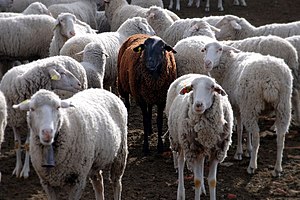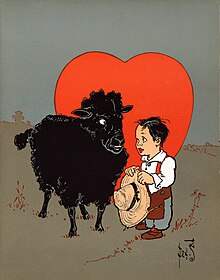In theEnglish language,black sheepis anidiomthat describes a member of a group who is different from the rest, especially afamilymember who does not fit in. The term stems fromsheepwhose fleece is colored black rather than the more common white; these sheep stand out in the flock and their wool is worth less as it will not dye.


The term has typically been given negative implications, implying waywardness.[1]
Inpsychology,"black sheep effect" refers to the tendency of group members to judge likeable ingroup members more positively and deviantingroupmembers more negatively than comparableoutgroupmembers.[2]
Origin
editIn mostsheep,a white fleece is not caused byalbinismbut by a commondominantgene that switches color production off, thus obscuring any other color that may be present.[3]A black fleece is caused by arecessivegene,[4]so if a white ram and a white ewe are eachheterozygousfor black, about one in four of their lambs will be black. In most white sheep breeds, only a few white sheep are heterozygous for black, so black lambs are usually much rarer than this.[5]
Idiomatic usage
editThe term originated from the occasional black sheep which are born into a flock of white sheep. Black wool is considered commercially undesirable because it cannot be dyed.[1]In 18th and 19th century England, the black color of the sheep was seen as the mark of the devil.[6]In modern usage, the expression has lost some of its negative connotations, though the term is usually given to the member of a group who has certain characteristics or lack thereof deemed undesirable by that group.[7]Jessica Mitforddescribed herself as "the red sheep of the family", acommunistin a family of aristocraticfascists.[8]
The idiom is also found in other languages, e.g.German,Finnish,French,Italian,Serbo-Croatian,Bulgarian,Hebrew,Portuguese,Greek,Turkish,Hungarian,Dutch,Afrikaans,Swedish,Danish,Spanish,Catalan,Czech,Slovak,RomanianandPolish.During theSecond Spanish Republica weekly magazine namedEl Be Negre,meaning 'The Black Sheep', was published inBarcelona.[9]
The same concept is illustrated in some other languages by the phrase "white crow": for example,belaya vorona(бе́лая воро́на) inRussianandkalāg-e sefīd(کلاغ سفید) inPersian.
In psychology
editIn 1988, Marques, Yzerbyt and Leyens conducted an experiment where Belgian students rated the following groups according to trait-descriptors (e.g. sociable, polite, violent, cold): unlikeable Belgian students, unlikeable North African students, likeable Belgian students, and likeable North African students. The results indicated that favorability is considered highest for likeable ingroup members and lowest for unlikeable ingroup members, with the favorability of unlikeable and likeable outgroup members lying between the two ingroup members.[2]These extreme judgements of likeable and unlikeable (i.e., deviant) ingroup members, relatively to comparable outgroup members is called "black sheep effect". This effect has been shown in variousintergroupcontexts and under a variety of conditions, and in many experiments manipulating likeability and norm deviance.[10][11][12][13]
Explanations
editA prominent explanation of the black sheep effect derives from the social identity approach (social identity theory[14]andself-categorization theory[15]). Group members are motivated to sustain a positive and distinctivesocial identityand, as a consequence, group members emphasize likeable members and evaluate them more positive than outgroup members, bolstering the positive image of their ingroup (ingroup bias). Furthermore, the positive social identity may be threatened by group members who deviate from a relevant group norm. To protect the positive group image, ingroup members derogate ingroup deviants more harshly than deviants of an outgroup.[16]
Eidelman and Biernat wrote in 2003 that personal identities are also threatened through deviant ingroup members. They argue that devaluation of deviant members is an individual response of interpersonal differentiation.[17]Khan and Lambert suggested in 1998 thatcognitive processessuch as assimilation and contrast, which may underline the effect, should be examined.[12]
Limitations
editEven though there is wide support for the black sheep effect, the opposite pattern has been found, for example, that White participants judge unqualified Black targets more negatively than comparable White targets.[18][19]Consequently, there are several factors which influence the black sheep effect. For instance, the higher theidentificationwith the ingroup, and the higher theentitativityof the ingroup, the more the black sheep effect emerges.[20][21]Even situational factors explaining the deviance have an influence whether the black sheep effect occurs.[22]
See also
editReferences
edit- ^abAmmer, Christine (1997).American Heritage Dictionary of Idioms.Houghton Mifflin Harcourt. p.64.ISBN978-0-395-72774-4.Retrieved2007-11-13.
- ^abMarques, J. M.; Yzerbyt, V. Y.; Leyens, J. (1988). "The 'Black Sheep Effect': Extremity of judgments towards ingroup members as a function of group identification".European Journal of Social Psychology.18:1–16.doi:10.1002/ejsp.2420180102.
- ^"Scientists Identify Genetic Basis for the Black Sheep of the Family".ScienceDaily.Retrieved2024-04-30.
- ^"Genetics of Coloured Sheep".Black & Coloured Sheep Breeders’ Association of New Zealand.Retrieved2024-05-30.
- ^Norris, B. J.; Whan, V. A. (2008)."A Gene Duplication Affecting Expression of the OvineASIPGene is Responsible for White and Black Sheep ".Genome Research.18(8): 1282–1293.doi:10.1101/gr.072090.107.PMC2493430.PMID18493018.Retrieved2024-05-30.
- ^Sykes, Christopher Simon (1983).Black Sheep.New York:Viking Press.p. 11.ISBN978-0-670-17276-4.
- ^The American Heritage Dictionary of Idioms.Houghton Mifflin Company. 1992.Archivedfrom the original on 2008-04-15.Retrieved2008-03-24.
- ^"Red Sheep: How Jessica Mitford found her voice"by Thomas Mallon 16 Oct 2007New YorkerArchived6 June 2011 at theWayback Machine.
- ^El be negre (1931-1936) - La CibernizArchived2013-02-11 at theWayback Machine
- ^Branscombe, N.; Wann, D.; Noel, J.; Coleman, J. (1993). "In-group or out-group extremity: Importance of the threatened social identity".Personality and Social Psychology Bulletin.19(4): 381–388.doi:10.1177/0146167293194003.S2CID144403591.
- ^Coull, A.; Yzerbyt, V. Y.; Castano, E.; Paladino, M.-P.; Leemans, V. (2001). "Protecting the ingroup: Motivated allocation of cognitive resources in the presence of threatening ingroup members".Group Processes & Intergroup Relations.4(4): 327–339.CiteSeerX10.1.1.379.3383.doi:10.1177/1368430201004004003.S2CID16867772.
- ^abKhan, S.; Lambert, A. J. (1998). "Ingroup favoritism versus black sheep effects in observations of informal conversations".Basic and Applied Social Psychology.20(4): 263–269.doi:10.1207/s15324834basp2004_3.
- ^Pinto, I. R.; Marques, J. M.; Levine, J. M.; Abrams, D. (2010). "Membership status and subjective group dynamics: Who triggers the black sheep effect?".Journal of Personality and Social Psychology.99(1): 107–119.doi:10.1037/a0018187.PMID20565188.
- ^Worchel, S.; Austin, W. G. (1979).The Social psychology of intergroup relations.Monterey, CA: Brooks-Cole.
- ^Turner, J. C.; Hogg, M. A.; Oakes, P. J.; Reicher, S. D.; Wetherell, M. S. (1987).Rediscovering the Social group: A self-categorization theory.Oxford: Blackwell.
- ^Hogg, M. A.; Tindale, S. (2001).Blackwell handbook of social psychology: group processes.Malden, Mass: Blackwell.
- ^Eidelman, S.; Biernat, M. (2003). "Derogating black sheep: Individual or group protection?".Journal of Experimental Social Psychology.39(6): 602–609.doi:10.1016/S0022-1031(03)00042-8.
- ^Feldman, J. M. (1972). "Stimulus characteristics and subject prejudice as determinants of stereotype attribution".Journal of Personality and Social Psychology.21(3): 333–340.doi:10.1037/h0032313.
- ^Linville, P. W.; Jones, E. E. (1980). "Polarized appraisals of out-group members".Journal of Personality and Social Psychology.38(5): 689–703.doi:10.1037/0022-3514.38.5.689.
- ^Castano, E.; Paladino, M.; Coull, A.; Yzerbyt, V. Y. (2002). "Protecting the ingroup stereotype: Ingroup identification and the management of deviant ingroup members".British Journal of Social Psychology.41(3): 365–385.doi:10.1348/014466602760344269.PMID12419008.S2CID2003883.
- ^Lewis, A. C.; Sherman, S. J. (2010). "Perceived entitativity and the black-sheep effect: When will we denigrate negative ingroup members?".The Journal of Social Psychology.150(2): 211–225.doi:10.1080/00224540903366388.PMID20397595.S2CID31260933.
- ^De Cremer, D.; Vanbeselaere, N. (1999)."I am deviant, because...: The impact of situational factors upon the black sheep effect".Psychologica Belgica.39:71–79.doi:10.5334/pb.942.
External links
edit- Exploration of the etymology of the phrase "black sheep of the family"
- Marques, José M.; José M. Marques; Vincent Y. Yzerbyt (1988)."The black sheep effect: Judgmental extremity towards ingroup members in inter-and intra-group situations".European Journal of Social Psychology.18(3): 287–292.doi:10.1002/ejsp.2420180308.Retrieved2008-01-04.